This June, we’re taking a look at some classic Star Trek movie tie-ins and other interesting objects. Check back daily for the latest reviews and retrospectives.
Khan is a massively important figure in the grand mythology of Star Trek.
One need only look to Star Trek Into Darkness as proof of that assertion – a film that trades on how iconic the name “Khan” is, even to the most casual of fans. However, despite the fact that Khan has only appeared in a single episode and two feature films, each spaced apart by more than a decade, the character continues to exert a strong pull over the rest of the franchise. He is arguably more iconic and well-known than any lead character from a show produced after Star Trek: The Next Generation.
After all, Khan’s influence can be felt on just about every iteration of the franchise. On Star Trek: Deep Space Nine, he haunted the character of Julian Bashir. When the fourth season of Star Trek: Enterprise began its high-profile journey into the franchise’s continuity, Khan became something of a touchstone. The season’s first three-part episode (Borderland, Cold Station 12 and The Augments) was devoted to exploring the legacy of Khan Noonien Singh. Indeed, the show even tied Khan into the origin of the flat-foreheaded Klingons in Affliction and Divergence.
And yet, despite all this, there really is only so much material the character can support. Khan Noonien Singh is an iconic bad guy, but there’s a point where he ends up over-saturated.
Ruling in Hell, a four-part miniseries from IDW comics, would seem to be that point. The comic covers Khan’s period in exile on Ceti Alpha V between the events of Space Seed and Star Trek II: The Wrath of Khan. This would seem to be an interesting story to tell. After all, Khan is a man who once ruled over a portion of the Earth, so it might be interesting to watch his descent and decay into the bitter madman who threw everything away so he might pursue Captain James Tiberius Kirk.
There is just one problem. This story has already been told. Ruling in Hell was published in 2011, two years before the release of Star Trek Into Darkness and two years following the release of IDW’s comic book adaptation of Star Trek II: The Wrath of Khan. It was also released five years following the publication of Greg Cox’s To Reign in Hell: The Exile of Khan Noonien Singh, a prestigious Pocket Books novel that covered the exact same period in the life of the would-be tyrant.
This is a story that has already been told, just not on screen. Indeed, with a prestigious hardcover release as a sequel to Cox’s well-received Eugenics Wars duology, To Reign in Hell had just about the highest profile release possible for a Star Trek tie-in novel. As such, Ruling in Hell feels like it is retreading familiar ground. It’s perhaps a commentary on the character of Khan that the character is so iconic and so well-loved that there is a market for two different accounts of a particular gap in his personal continuity.
And, to be clear, there’s no issue with continuity here. After all, none of the tie-in materials are considered “canon” in any way that matters. There’s absolutely no problem with having two different versions of the same story told in different media. Indeed, IDW’s own on-going Star Trek series had launched with a bunch of adaptations of classic Star Trek stories to fit within the confines of JJ Abrams’ re-tooled Star Trek. Sulu has assumed command of the Excelsior in a number of different ways, in a number of different stories.
However, one might imagine that there are only so many ways to fill in the blanks left between Space Seed and Star Trek II: The Wrath of Khan. Inevitably, the story beats start to feel the same. In The Wrath of Khan, Khan reveals that Moira McGivers died as a victim of the Ceti Eel. However, both Ruling in Hell and To Reign in Hell offer a disappointing similar account of the events. Khan finds himself facing off against a bunch of mutinous followers, who murder McGivers while trying to use her to assassinate Khan.
It’s a pretty clever twist on the story as told in The Wrath of Khan, but it’s one that feels a bit less impressive the second time that it has been told. The biggest problem with Ruling in Hell is that it feels like an inferior version of a narrative that has already been told, with the story never really distinguishing itself from what came before. The plot plays out in a fashion that fits logically between Khan’s on-screen appearances, but also in a way that follows the rough arc of To Reign in Hell.
To be fair to writers Scott and Dave Tipton, they do try to put their own stamp on some of the tragedy at play here, emphasising that Kirk does share some of the blame for what happened. When Scott asks Kirk why he is giving Khan a planet, Kirk responds, “I’d much rather have Khan ruling his small corner of the galaxy than actively trying to deprive us of ours.” It suggests a less altruistic and less romantic reason for the decision than Kirk suggested in Space Seed. Kirk is arguing that Khan is best left as somebody else’s problem, and has no interest beyond that.
The Tiptons also work hard to justify Khan’s hatred and resentment of Kirk. It is not enough that Kirk planted Khan on Ceti Alpha V, a decision that led to the death of his people and his wife. The Wrath of Khan heavily indicated that Khan was projecting his own sense of guilt and responsibility on to Kirk, which is arguably enough psychological depth for the character. The Tiptons push it just a little bit further. Khan resents Kirk as much for failing to save him as he does for stranding him in the first place.
When the neighbouring planet explodes, Khan doesn’t seem too bothered. “Besides, surely Starfleet will be keeping a watchful eye on our progress, as much for their best interest as our own,” he observes – and he’s correct, that would make sense. Again, Ruling in Hell suggests that Kirk does bare some measure of responsibility for the death of Khan’s followers, and his actions were short-sighted and self-serving.
However, Khan spends the immediate aftermath of the explosion patiently awaiting rescue. This is what causes the division among the ranks. “Not everyone among us is content to wait patiently for the return of the Enterprise,” Joachim assures him, and – as ever – Khan’s young servant has his finger on the pulse. Khan’s trust in Kirk delays his response to the crisis, and allows descent to develop in the ranks of his followers, thus escalating the situation.
It’s a nice way of underscoring just how much Khan would come to hate Kirk, but it doesn’t feel entirely in-character. Khan might grudgingly respect Kirk as a man who bested him in physical combat and warfare, but Khan never necessarily trusted Kirk. More than that, Khan prides himself as the epitome of a certain sort of dynamism and strength. It seems very out-of-character for Khan to sit around idly and await rescue from another individual.
Khan was a man who believe that he bent the world to his will. Even as Ceti Alpha V falls to pieces around him, it feels out of character for Khan to wait for assistance. It’s probably the biggest difference between Ruling in Hell and To Reign in Hell, and it feels like the Tiptons don’t have as firm a grasp on Khan Noonien Singh as Greg Cox did. As such, it marks Ruling in Hell as the weaker of the two stories, by default.
(It’s also worth noting that the title betrays the same blind fidelity to continuity that we’ve come to expect from IDW Star Trek comic books. For example, Marla walks around in that creepy fan-service-y wire measure from Space Seed, as worn by all the other female members of Khan’s crew. It was a blatant bit of audience titillation even in the sixties, and it makes little sense as jungle (or desert) planet survival gear. It seems like it is included because… well, it was in the original episode, and that means it’s continuity.)
Still, it is a testament to the character of Khan Noonien Singh that he has such an impact on the franchise. Even decades after his first appearance, the character seems to be a centre of gravity so heavy that stories warp around him. This is particularly surreal, given that the character isn’t especially flexible. There would seem to be a finite number of Star Trek narratives that you can casually construct around Khan while retaining his most iconic attributes.
This is arguably evident from his on-screen appearances. After all, the Augments trilogy from Enterprise felt like it borrowed a little too heavily from The Wrath of Khan, with the entirety of Cold Station 12 playing like an outtake from Khan’s visit to Regula I. Entire segments of The Wrath of Khan were grafted on to the climax of Star Trek Into Darkness. It would appear that the logic applies just as much to Khan’s appearances outside the films and television shows.
Perhaps there is a limit to just how far you can stretch the character of Khan Noonien Singh, before you end up with nothing but pale imitations and echoes.
Filed under: Comics, Star Trek | Tagged: Comics, dave tipton, idw, khan, Khan Noonien Singh, scott tipton, star trek, star trek ii, Star Trek II: The Wrath of Khan |















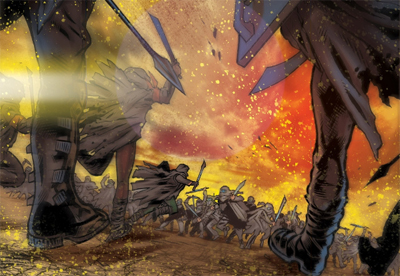
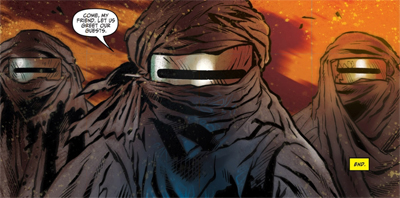

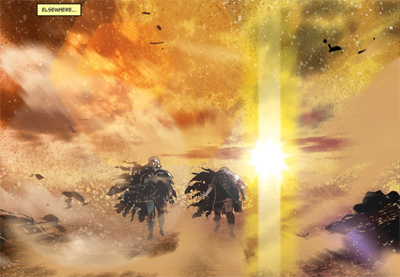

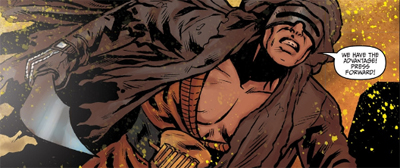

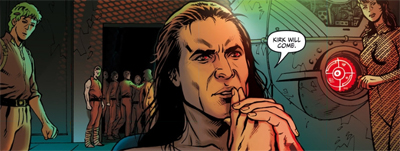






Have you read the IDW Khan comic that just came out (prequel to Into Darkness)? It too is supposed to cover ground that Cox already wrote about (the Eugenics Wars) but from what I hear it’s more of its own story, making Khan the actual dictator that he was implied to be onscreen, rather than the behind-the-scenes criminal mastermind who manipulated real history that we saw in the books.
Actually, I have yet to pick it up. I am considering waiting for an IDW sale, or I may take a look at it when I get to the fourth season of Enterprise… or maybe the fifth season of DS9. (I am not very good at mapping out the supplemental material I plan to cover in advance, tending to miss things and occasionally having to cheat or circle back – arguably this whole month counts as circling back, given I’ve already looked at the film.)
I would like to see a story focusing on the mirror khan taking on mirror enterprise and crew. This would be epic, you could have khan playing good guy role and enterprise is the unstoppale force. Or both bad. Just want to see thiss
That would be interesting. Actually, I’m not sure if we’ve ever met mirror universe Khan?